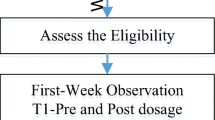Abstract
Telemetric recordings of field potentials from frontal cortex, hippocampus, striatum and reticular formation of freely moving rats were analysed before and after injection of the enantiomeric hallucinogenic amphetamine derivatives R-DOB [(−)-1-(2,5-dimethoxy-4-bromophenyl)-2-aminopropane], R-DOM [(−)-1-(2,5-dimethoxy-4-methylphenyl)-2-amino-propane] and R-DOI [(−)-1-(2,5-dimethoxy-4-iodophenyl)-2-aminopropanel] as well as the nonhallucinogenic amphetamine derivatives S-MBDB [(+)-N-methyl-1-(1,3-benzodioxol-5-yl)butanamine] and S-MDMA [(+)-3,4-methylenedioxymethamphetamine] and S-(+)-amphetamine. The frequency analysis of the field potentials revealed a clearcut difference between them. The spectral patterns emerging after injection of the non-hallucinogens were characterized by a general decrease of power, the changes in the alpha2 and delta band being the most prominent, whereas only after the application of the hallucinogenic compounds was a contrasting increase of power observed in the alpha1 frequency band, especially in the striatum. As increases in alpha1 power have been correlated in the same pharmacological model to serotonergic control mechanisms, the results are in line with the hypothesis that 5-HT2 receptors, predominantly occurring in the striatum, might be involved in the hallucinogenic action of drugs.
Similar content being viewed by others
References
Ahrens H, Läuter J (1974) Mehrdimensionale Varianzanalyse. Akademieverlag, Berlin
Dimpfel W, Spüler M, Nickel B, Tibes U (1986a) ‘Fingerprints’ of central stimulatory drug effects by means of quantitative radioencephalography in the rat (Tele-Stereo-EEG). Neuropsychobiology 15:101–108
Dimpfel W, Spüler M, Nickel B (1986b) Radioelectroencephalography (Tele-Stereo-EEG) in the rat as a pharmacological model to differentiate the central action of flupirtine from that of opiates, diazepam and phenobarbital. Neuropsychobiology 16:163–168
Dimpfel W, Spüler M, Koch R, Schatton W (1987) Radioelectroencephalographic comparison of memantine with receptor-specific drugs acting on dopaminergic transmission in freely moving rats. Neuropsychobiology 18:212–218
Dimpfel W, Spüler M, Borbe HO (1988) Monitoring of the effects of antidepressant drugs in the freely moving rat by radioelectroencephalography (Tele-Stereo-EEG). Neuropsychobiology 19:116–120
Glennon RA, Titeler M, Young R (1986) Structure-activity relationships and mechanism of action of hallucinogenic agents based on drug discrimination and radioligand binding studies. Psychopharmacol Bull 22:953–958
Johnson MP, Hoffmann AJ, Nichols DE (1986) Effects of the enantiomers of MDA, MDMA and related analogues on [3H]serotonin and [3H]dopamine release from superfused rat brain slices. Eur J Pharmacol 132:269–276
Lyon RA, Titeler M, Seggel MR, Glennon RA (1988) Indolealkylamine analogs share 5-HT2 binding characteristics with phenylalkylamine hallucinogens. Eur J Pharmacol 145:292–297
Nichols DE, Oberlender RA (1989) Structure-activity relationships of MDMA-like substances. In: National Institute on Drug Abuse. Res Monogr Ser (in press)
Oberlender R, Nichols DE (1988) Drug discrimination studies with MDMA and amphetamine. Psychopharmacology 95:71–76
Pazos A, Palacios JM (1985) Quantitative autoradiographic mapping of serotonin receptors in the rat brain. I. Serotonin-1-receptors. Brain Res 346:205–230
Pazos A, Cortés R, Palacios JM (1985) Quantitative autoradiographic mapping of serotonin receptors in the rat brain. II. Serotonin-2-receptors. Brain Res 346:231–249
Steele TD, Nichols DE, Yim GKW (1987) Stereochemical effects, of 3,4-methylenedioxymethamphetamine (MDMA) and related amphetamine derivatives on inhibition of uptake of [3H]-monoamines into synaptosomes from different regions of the rat brain. Biochem Pharmacol 36:2297–2303
Titeler M, Lyon RA, Glennon RA (1988) Radioligand binding evidence implicates the brain 5-HT2-receptor as a site of action for LSD and phenylisopropylamine hallucinogens. Psychopharmacology 94:213–216
Yamamoto BK, Spanos LJ (1988) The acute effects of methylene-dioxymethamphetamine on dopamine release in the awake-behaving rat. Eur J Pharmacol 148:195–204
Young R, Glennon RA (1986) Discriminative stimulus properties of amphetamine and structurally related phenalkyamines. Med Res Res 6:99–130
Author information
Authors and Affiliations
Rights and permissions
About this article
Cite this article
Dimpfel, W., Spüler, M. & Nichols, D.E. Hallucinogenic and stimulatory amphetamine derivatives: fingerprinting DOM, DOI, DOB, MDMA, and MBDB by spectral analysis of brain field potentials in the freely moving rat (Tele-Stereo-EEG). Psychopharmacology 98, 297–303 (1989). https://doi.org/10.1007/BF00451678
Received:
Accepted:
Issue Date:
DOI: https://doi.org/10.1007/BF00451678




